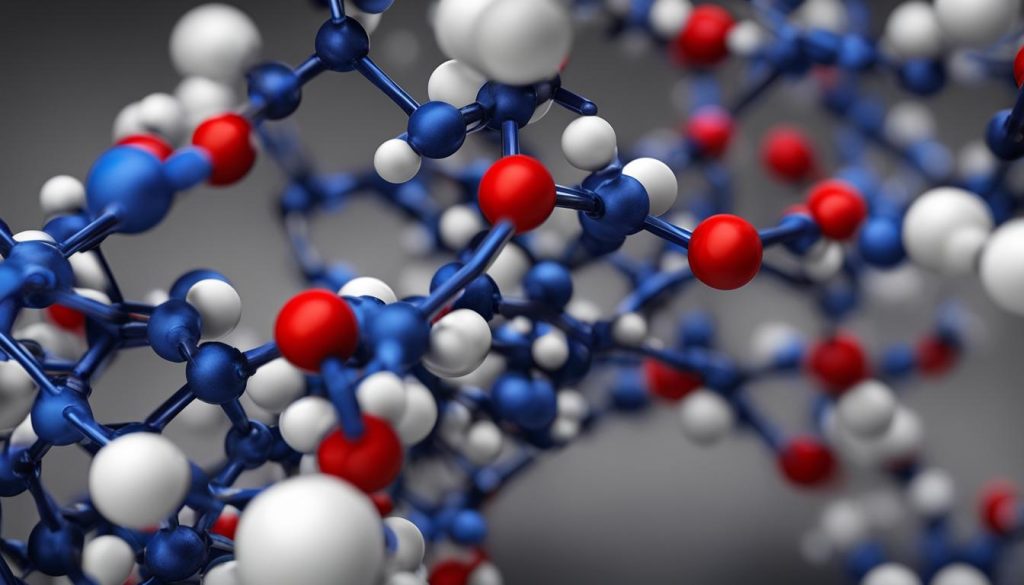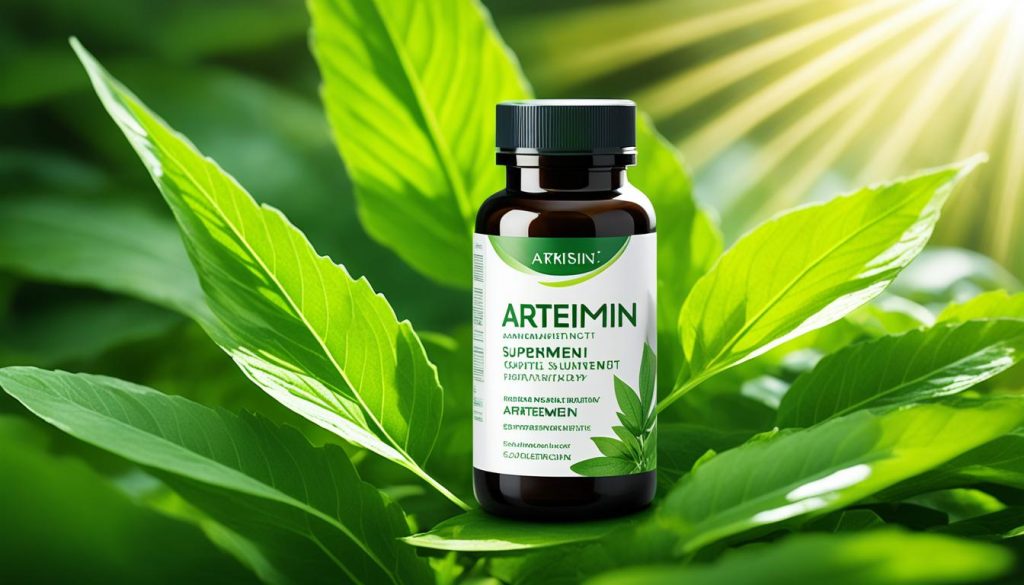Glad to have you on our post about artemisinin dietary supplements! You are at the right spot if you’re intrigued about this herbal supplement and the potential advantages it may hold. Artemisinin is a supplement extracted from the sweet wormwood plant, traditionally used in the treatment of malaria. Yet, its applications are not confined to treat only malaria; current research is examining its likely effectiveness in managing other health issues, such as cancer, Lyme disease, and even autoimmune diseases.
Key Takeaways:
- Artemisinin is a dietary supplement derived from the sweet wormwood plant.
- It is primarily used to treat malaria and is also being studied for its potential in addressing other conditions.
- The supplement may have potential benefits for cancer, Lyme disease, and autoimmune disorders.
- Artemisinin is known for its anti-inflammatory, antioxidant, and antimicrobial properties.
- Consult with a healthcare professional before starting any new dietary supplement.
What is Artemisinin?
Artemisinin, derived from the sweet wormwood plant, is a dietary supplement known for its medicinal properties. Primarily used to treat malaria, it is gaining attention for its potential in addressing other health conditions, including cancer, Lyme disease, and autoimmune disorders.
While artemisinin’s effectiveness in treating malaria is well-established, ongoing research is exploring its therapeutic applications in diverse areas. This promising supplement has the potential to revolutionize treatment options for various ailments and improve overall health and well-being.
Artemisinin and Malaria
Artemisinin has long been recognized for its powerful antimalarial properties. It is effective against Plasmodium falciparum, the strain responsible for the most severe form of malaria. The supplement works by causing damage to the parasite’s cell membranes, ultimately leading to its destruction.
Due to its potent antimalarial activity, artemisinin has become a vital part of artemisinin-based combination therapy (ACT), the recommended treatment for uncomplicated malaria by the World Health Organization (WHO).
Artemisinin and Potential Applications
Beyond malaria treatment, artemisinin shows promise in combatting other diseases. Research suggests that it may have anticancer properties, inhibiting the growth and spread of cancer cells. Scientists are investigating its potential in various cancer types, including breast, colon, lung, and leukemia.
The supplement’s antibacterial and anti-inflammatory properties also make it a potential candidate for addressing Lyme disease, an infectious condition caused by tick bites. Furthermore, its immunomodulatory effects have led to studies exploring its use in managing autoimmune disorders, such as rheumatoid arthritis and systemic lupus erythematosus.
Artemisinin’s potential extends even further. Let’s take a closer look at its applications in the food industry.
Artemisinin in the Food Industry
Artemisinin finds application in the food industry for its multifaceted benefits. Here are some ways it is used:
- Antioxidant: Artemisinin acts as an antioxidant, preserving food products by inhibiting oxidation and extending their shelf life.
- Preservative: Its antimicrobial properties help prevent the growth of bacteria and microorganisms, reducing the risk of food-borne illnesses.
- Flavor Enhancer: Artemisinin enhances the flavor and aroma of food, making it a valuable addition to various culinary creations.
These diverse applications within the food industry demonstrate the versatility and potential of artemisinin beyond its traditional use.
Where is Artemisinin Used?
Artemisinin, derived from the sweet wormwood plant, is primarily used in the treatment of malaria, a life-threatening parasitic disease caused by the Plasmodium parasite. Malaria is a global health concern, especially prevalent in regions with a high incidence of mosquito-borne infections. Artemisinin-based combination therapies (ACTs) are the recommended treatment for uncomplicated malaria, as they have shown high efficacy in reducing parasite levels and clearing the infection.
In addition to its use against malaria, artemisinin is also utilized for the treatment of other parasitic infections. One such infection is babesiosis, a tick-borne illness caused by the Babesia parasite. Artemisinin has demonstrated efficacy against Babesia, aiding in the clearance of the infection and relieving symptoms. Another parasitic infection where artemisinin is used is schistosomiasis, a disease caused by parasitic worms called schistosomes. Artemisinin derivatives have shown potential in reducing the worm burden and preventing the complications associated with schistosomiasis.
Artemisinin is a valuable weapon in the fight against malaria and other parasitic infections, saving countless lives and improving global health.
Table: Examples of Parasitic Infections Treated with Artemisinin:
| Parasitic Infection | Treatment |
|---|---|
| Malaria | Artemisinin-based combination therapies (ACTs) and other antimalarial drugs |
| Babesiosis | Artemisinin and other antiprotozoal medications |
| Schistosomiasis | Artemisinin derivatives and other antiparasitic agents |
Artemisinin’s antiparasitic properties make it an essential component in the treatment of infectious diseases, offering hope in the fight against these debilitating conditions.
How is Artemisinin used in the Food Industry?
Artemisinin plays a significant role in the food industry as an antioxidant, preservative, and flavor enhancer. Its unique properties make it a valuable ingredient in a variety of food products.
As an antioxidant, Artemisinin helps prevent the oxidation of fats and oils in food, thereby extending their shelf life. This is particularly beneficial in the production of packaged and processed foods, as it helps maintain their freshness and quality over an extended period. By inhibiting the formation of free radicals, Artemisinin reduces the risk of rancidity and preserves the nutritional value of the food.
Artemisinin also acts as a preservative by inhibiting the growth of bacteria and other microorganisms. This helps to prevent food spoilage and reduce the risk of food-borne illnesses. Its antimicrobial properties make it an effective natural alternative to chemical preservatives, adding value to food products that emphasize natural and clean-label ingredients.
Moreover, Artemisinin enhances the flavor and color of food, making it a popular choice for application in the food industry. Its ability to intensify taste and aroma makes it an excellent flavor enhancer, adding complexity and depth to various dishes and beverages.
| Benefits of Artemisinin in Food Industry |
|---|
| Prolongs shelf life by preventing oxidation |
| Reduces the risk of food-borne illnesses |
| Natural alternative to chemical preservatives |
| Enhances flavor and aroma of food |
Overall, Artemisinin’s presence in the food industry not only improves the quality and safety of food products but also offers consumers an enhanced sensory experience by enhancing flavor, preventing spoilage, and maintaining freshness.

Health Benefits of Artemisinin
Artemisinin, derived from the sweet wormwood plant, offers a range of health benefits that can positively impact overall well-being. Its anti-inflammatory, anti-bacterial, and anti-viral properties help boost the immune system, providing defense against various diseases and infections.
One noteworthy benefit of artemisinin is its potential in reducing the risk of certain types of cancer. Research suggests that artemisinin may inhibit the growth of cancer cells and induce apoptosis, making it a promising component in cancer treatment.
Moreover, artemisinin has been associated with improved cardiovascular health. It exhibits vasodilatory effects, which can help lower blood pressure and enhance blood flow. This contributes to better heart health and reduced risk of cardiovascular diseases.
For individuals suffering from allergies, asthma, or respiratory conditions, artemisinin may provide relief. Its anti-inflammatory properties can alleviate symptoms and promote easier breathing.
Additionally, artemisinin assists in improving digestion, making it beneficial for individuals with gastrointestinal issues. It aids in reducing inflammation in the gut and supports healthy digestion and nutrient absorption.
Another advantage of artemisinin is its potential to counter fatigue and increase energy levels. By enhancing mitochondrial function and reducing oxidative stress, artemisinin can combat fatigue and promote sustained energy throughout the day.
Overall, artemisinin has the potential to improve various aspects of health, from boosting the immune system to reducing the risk of cancer and enhancing cardiovascular health. Its anti-inflammatory properties also make it beneficial for allergies, respiratory conditions, and digestion. Additionally, its ability to combat fatigue and increase energy levels can significantly improve overall well-being.
| Health Benefits of Artemisinin | Conditions |
|---|---|
| Boosting the immune system | Infections, autoimmune disorders |
| Reducing the risk of certain types of cancer | Cancer |
| Enhancing cardiovascular health | Heart diseases, high blood pressure |
| Alleviating symptoms of allergies and respiratory conditions | Allergies, asthma, respiratory conditions |
| Improving digestion | Gastrointestinal issues |
| Reducing fatigue and increasing energy levels | Fatigue, low energy |
What are the dangers of Artemisinin?
While Artemisinin is generally considered safe, it is important to be aware of potential side effects, interactions, and safety considerations before taking this dietary supplement.
Potential side effects
Artemisinin may cause the following side effects:
- Nausea
- Vomiting
- Diarrhea
- Abdominal pain
- Dizziness
- Headache
- Rash
These side effects can vary in severity and may occur in some individuals who take Artemisinin. If you experience any of these symptoms while using Artemisinin, it is important to consult with your healthcare provider.
Interactions with medications
Artemisinin can interact with certain medications, particularly anticoagulants (blood thinners). This interaction can increase the risk of bleeding. It is important to inform your healthcare provider about all the medications you are taking, including any dietary supplements, to ensure there are no potential interactions.
Ensuring safety
Before taking Artemisinin, it is advisable to consult with a healthcare professional. They can evaluate your medical history, current medications, and individual needs to determine whether Artemisinin is safe and suitable for you. They can also provide guidance on the appropriate dosage and usage of this dietary supplement.
Taking precautions and seeking professional advice can help ensure the safe use of Artemisinin and minimize the potential risks associated with its use.

Example Products Containing Artemisinin
Artemisinin, the powerful compound derived from the sweet wormwood plant, is available in a variety of product forms to suit different preferences and needs. Whether you prefer capsules, tablets, tinctures, teas, syrups, powders, or extracts, there is an artemisinin product that can fit seamlessly into your routine. These diverse product options make it easier to incorporate the health benefits of artemisinin into your daily life.
Here are some popular example products containing artemisinin:
| Product Form | Description |
|---|---|
| Capsules | Easy-to-swallow capsules that contain a measured dose of artemisinin. |
| Tablets | Convenient tablets that can be taken with water for a quick artemisinin intake. |
| Tinctures | Alcohol-based liquid extracts that can be added to beverages or taken directly under the tongue. |
| Teas | Herbal teas infused with artemisinin for a soothing and refreshing way to consume this beneficial compound. |
| Syrups | Sweet syrups that can be easily measured and added to beverages or taken directly. |
| Powders | Fine powders that can be mixed into smoothies, shakes, or other favorite recipes. |
| Extracts | Potent extracts that can be used topically or added to skincare and cosmetic formulations. |
These example products offer different options for consuming artemisinin based on personal preferences and needs. Whether you prefer the convenience of capsules, the soothing effects of teas, or the versatility of powders, there is a product that can suit your lifestyle.
How is Artemisinin regulated across the world?
Artemisinin, a potent dietary supplement extracted from the sweet wormwood plant, undergoes varying regulatory processes worldwide. As regulations aim to ensure safety and quality, different organizations assume responsibility for overseeing its distribution and use.
Regulation in the United States
In the United States, the Food and Drug Administration (FDA) classifies artemisinin as a dietary supplement. This categorization reflects the recognition of its potential health benefits and the need to monitor its production, labeling, and overall safety.
Regulation in the European Union
Meanwhile, in the European Union (EU), artemisinin is regulated as a food supplement by the European Food Safety Authority (EFSA). EFSA ensures consumer protection by evaluating and authorizing food supplements, including artemisinin, based on their safety and established daily intake levels.
Regulation in Australia
In Australia, the Therapeutic Goods Administration (TGA) oversees artemisinin as a therapeutic good. TGA’s role involves licensing artemisinin products, analyzing their safety, efficacy, and quality, and ensuring compliance with regulatory standards.
Regulation in Canada
Health Canada takes charge of regulating artemisinin as a natural health product. Through its Natural and Non-prescription Health Products Directorate, Health Canada assesses and monitors artemisinin products to ensure their safety, quality, and efficacy.
Regulation in India
The Central Drugs Standard Control Organization (CDSCO) regulates artemisinin as a drug in India. CDSCO’s primary objective is to ensure the safety and quality of artemisinin and other pharmaceutical drugs, contributing to the overall well-being of the population.
Overall, regulatory agencies such as the FDA, EFSA, TGA, Health Canada, and CDSCO play vital roles in enforcing standards, ensuring product quality, and safeguarding consumer health and well-being in relation to artemisinin and its various applications.
Regulatory Authorities for Artemisinin across the Globe
| Country/Region | Regulatory Authority |
|---|---|
| United States | Food and Drug Administration (FDA) |
| European Union | European Food Safety Authority (EFSA) |
| Australia | Therapeutic Goods Administration (TGA) |
| Canada | Health Canada |
| India | Central Drugs Standard Control Organization (CDSCO) |

The anti-inflammatory, antioxidant, and antimicrobial properties of artemisinin
Artemisinin, derived from the sweet wormwood plant, exhibits a range of beneficial properties that contribute to its potential therapeutic applications. Studies have demonstrated artemisinin’s anti-inflammatory effects, which primarily involve inhibiting the production of proinflammatory cytokines.
Furthermore, artemisinin possesses significant antioxidant activity, allowing it to scavenge free radicals and protect against oxidative stress. This antioxidant capacity helps maintain cellular health and may contribute to the prevention of chronic diseases.
In addition to its anti-inflammatory and antioxidant properties, artemisinin also exhibits antimicrobial activity against certain microorganisms. This antimicrobial effect demonstrates the potential for artemisinin to contribute to the treatment of various infections and diseases.
Overall, artemisinin’s anti-inflammatory, antioxidant, and antimicrobial properties make it a promising compound for potential therapeutic applications. Ongoing research continues to explore the full extent of its benefits and potential medical uses.
| Properties of Artemisinin | Description |
|---|---|
| Anti-inflammatory effect | Inhibits the production of proinflammatory cytokines |
| Antioxidant activity | Scavenges free radicals, protects against oxidative stress |
| Antimicrobial activity | Demonstrates efficacy against certain microorganisms |
The Structure of Artemisinin
Artemisinin is the main component of Artemisia annua L., a medicinal plant also known as sweet wormwood. It has a unique chemical structure that contributes to its pharmacological properties.
The chemical formula of artemisinin is C15H22O15, and it contains a peroxide bridge (C-O-O-C). This molecular structure plays a crucial role in the compound’s antimalarial activity and overall therapeutic effects.
Artemisinin belongs to the sesquiterpene lactone compound class, which refers to its organic compound composition containing 15 carbon atoms (C15). The lactone moiety refers to the presence of an oxygenated cyclic ester group.
This intricate structure of artemisinin contributes to its potent anti-malarial, anti-inflammatory, antioxidant, and antimicrobial properties. Understanding the structure of artemisinin is essential for comprehending its mode of action and potential applications in various fields of medicine.

| Chemical Formula | Structural Features | Pharmacological Properties |
|---|---|---|
| C15H22O15 | Peroxide bridge (C-O-O-C) | Antimalarial, anti-inflammatory, antioxidant, and antimicrobial |
Studies and Research on Artemisinin
Scientific research has extensively studied the therapeutic properties of artemisinin, shedding light on its potential use in treating various diseases. Studies have explored its effectiveness in combating diseases such as leishmaniasis, Chagas’ disease, and African sleeping sickness, showcasing promising results.
Artemisinin has also been investigated for its potential role in pain reduction in osteoarthritis, providing relief for individuals suffering from joint discomfort. Additionally, research has examined its effects on cancer cells, demonstrating its potential as a treatment option for certain types of cancer.
Furthermore, artemisinin extracts from the Artemisia annua L. plant have exhibited characteristics suitable for dental pharmaceuticals. Their remarkable anti-inflammatory, antioxidant, and antimicrobial properties make them potentially valuable for the treatment of dental diseases.
To summarize, scientific studies and research have highlighted the diverse therapeutic properties of artemisinin, showcasing its potential in the treatment of various diseases and its promising application in dental pharmaceuticals.
| Diseases | Research Findings |
|---|---|
| Leishmaniasis | Potential effectiveness of artemisinin in combating the disease. |
| Chagas’ disease | Promising results regarding the use of artemisinin as a treatment option. |
| African sleeping sickness | Exploring the potential of artemisinin in combating the disease. |
| Osteoarthritis | Potential for pain reduction in individuals with osteoarthritis. |
| Cancer | Investigating the effects of artemisinin on cancer cells. |
| Dental diseases | Potential application of artemisinin extracts in dental pharmaceuticals. |
Conclusion
Artemisinin, a dietary supplement derived from the sweet wormwood plant, has shown great promise in the treatment of malaria and is also being explored for its potential benefits in other conditions. This natural compound offers a range of health benefits, including its anti-inflammatory, antioxidant, and antimicrobial properties, which can contribute to supporting the immune system and improving overall well-being.
However, it is important to approach artemisinin supplementation with caution. Before incorporating it into your healthcare regimen, it is essential to consult with a healthcare professional to ensure safety and determine the appropriate dosage for your individual needs. Additionally, it’s crucial to be aware of any potential interactions with medications you may be taking.
While artemisinin dietary supplements can be a valuable addition to your health routine, it is essential to prioritize your safety and take into account your unique circumstances. By following the recommended dosage guidelines and seeking guidance from a healthcare professional, you can maximize the benefits offered by artemisinin while minimizing any potential risks.
FAQ
What is Artemisinin?
Artemisinin is a dietary supplement derived from the sweet wormwood plant. It is used to treat malaria and is also being studied for its potential to treat other conditions, such as cancer, Lyme disease, and autoimmune disorders.
Where is Artemisinin used?
Artemisinin is primarily used to treat malaria. It is also used to treat other parasitic infections, such as babesiosis and schistosomiasis.
How is Artemisinin used in the food industry?
Artemisinin is used in the food industry as an antioxidant and preservative. It helps preserve food products, protect them from oxidation and spoilage, and enhance their flavor and color. It can also reduce the risk of food-borne illnesses by inhibiting the growth of bacteria and other microorganisms.
What are the health benefits of Artemisinin?
Artemisinin has various health benefits. It has anti-inflammatory, anti-bacterial, and anti-viral properties, which can help boost the immune system. It is believed to reduce the risk of certain types of cancer and improve cardiovascular health. It may also alleviate symptoms of allergies, asthma, and respiratory conditions. Additionally, it can improve digestion, reduce fatigue, and increase overall energy levels.
What are the dangers of Artemisinin?
While Artemisinin is generally considered safe, there are potential side effects such as nausea, vomiting, diarrhea, abdominal pain, dizziness, headache, and rash. It can also interact with certain medications, particularly anticoagulants, leading to an increased risk of bleeding. It is important to consult with a doctor before taking Artemisinin to ensure its safety and suitability for individual needs.
What are some example products containing Artemisinin?
Artemisinin is available in various product forms including capsules, tablets, tinctures, teas, syrups, powders, and extracts.
How is Artemisinin regulated across the world?
Artemisinin is regulated differently across the world. In the United States, it is regulated as a dietary supplement by the Food and Drug Administration (FDA). In the European Union, it is regulated as a food supplement by the European Food Safety Authority (EFSA). In Australia, it is regulated as a therapeutic good by the Therapeutic Goods Administration (TGA). In Canada, it is regulated as a natural health product by Health Canada. In India, it is regulated as a drug by the Central Drugs Standard Control Organization (CDSCO).
What are the anti-inflammatory, antioxidant, and antimicrobial properties of Artemisinin?
Artemisinin has been found to have anti-inflammatory effects, exhibiting inhibitory effects on the production of proinflammatory cytokines. It also possesses antioxidant activity, scavenging free radicals, and protecting against oxidative stress. Additionally, artemisinin demonstrates antimicrobial activity against certain microorganisms.
What is the structure of Artemisinin?
Artemisinin, the main component of Artemisia annua L., has the chemical formula C15H22O15 and contains a peroxide bridge (C-O-O-C). It is a sesquiterpene lactone compound with various pharmacological properties.
What studies and research have been conducted on Artemisinin?
Scientific research has investigated the therapeutic properties of artemisinin, including its potential use in the treatment of various diseases, such as leishmaniasis, Chagas’ disease, and African sleeping sickness. Studies have also explored its potential for pain reduction in osteoarthritis, allergy symptom improvement, and its effects on cancer cells. Additionally, artemisinin extracts from Artemisia annua L. have been considered for use in dental pharmaceuticals due to their anti-inflammatory, antioxidant, and antimicrobial properties.
How should Artemisinin dietary supplements be used?
Artemisinin is a dietary supplement that should be taken according to the recommended dosage guidelines. It is important to consult with a healthcare professional before starting any dietary supplement regimen, especially if you are pregnant, breastfeeding, or have any underlying health conditions. Individual needs and circumstances should be taken into account.



